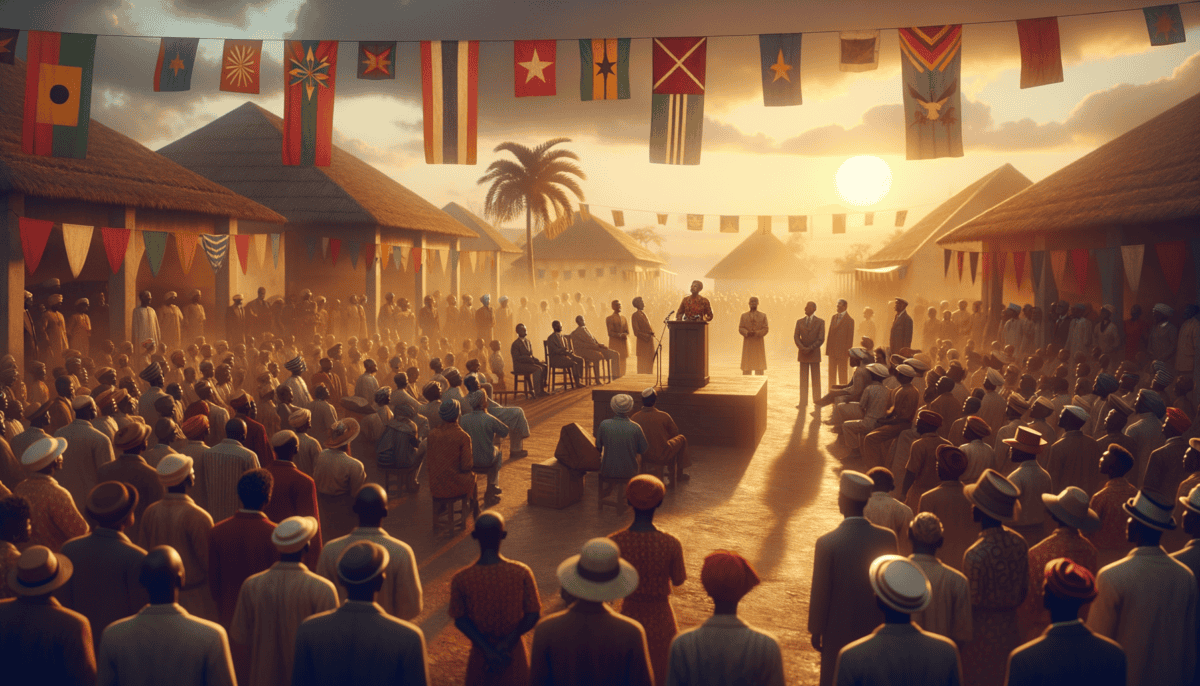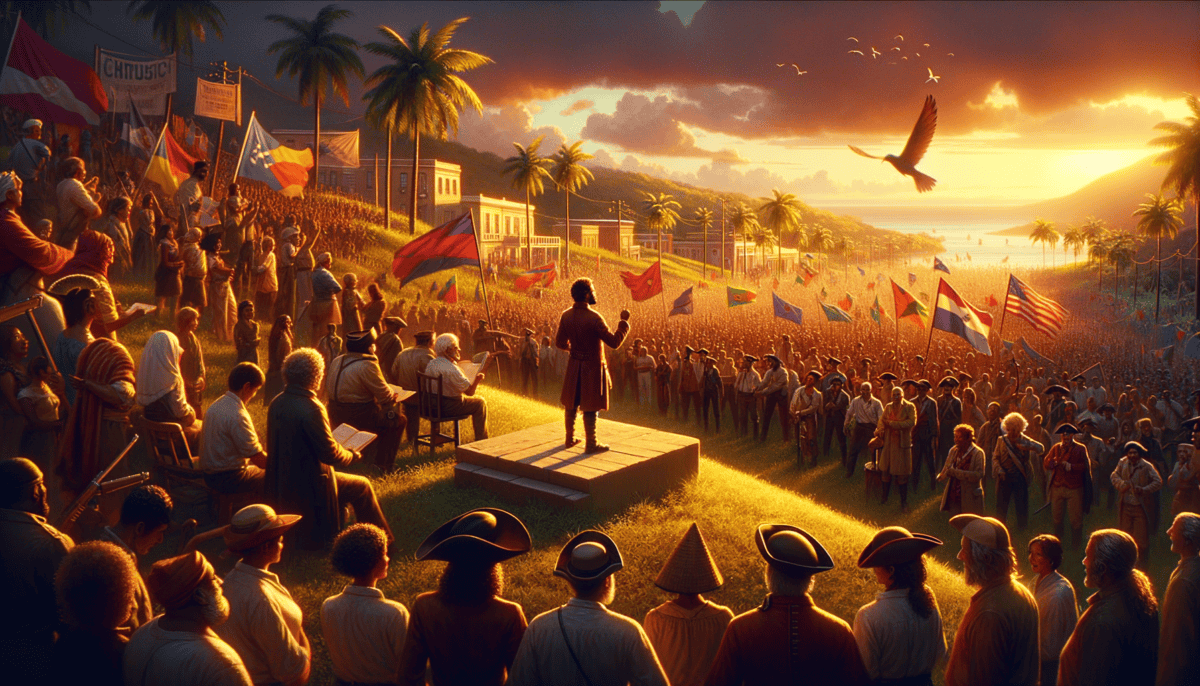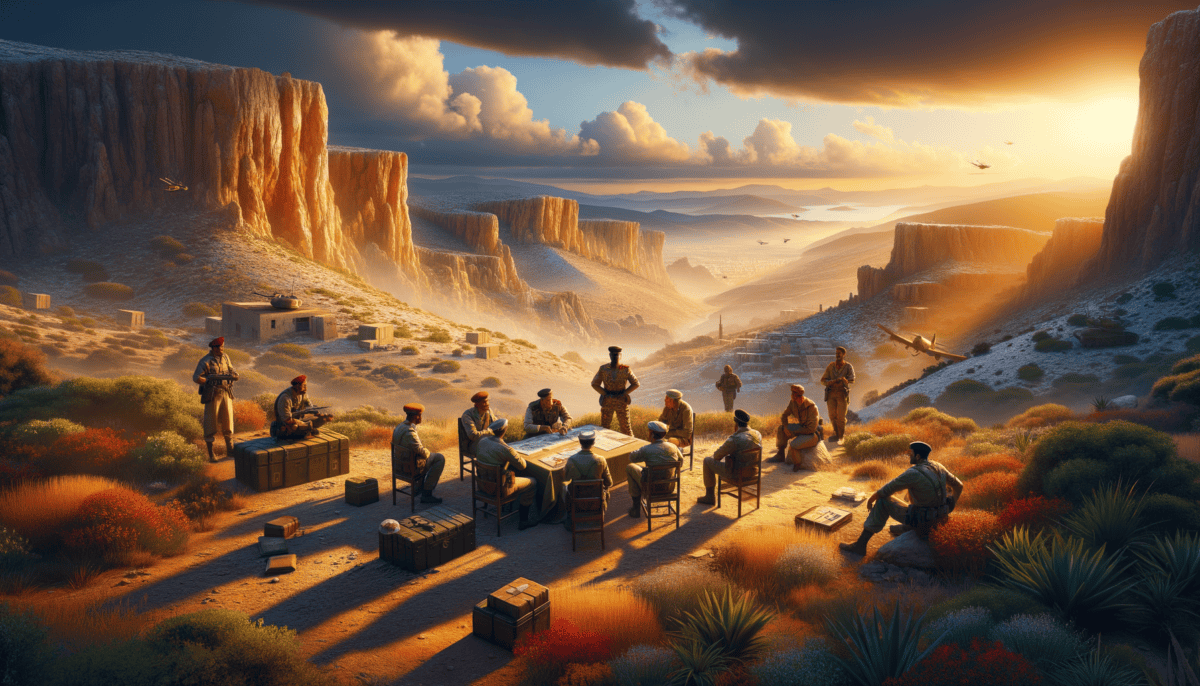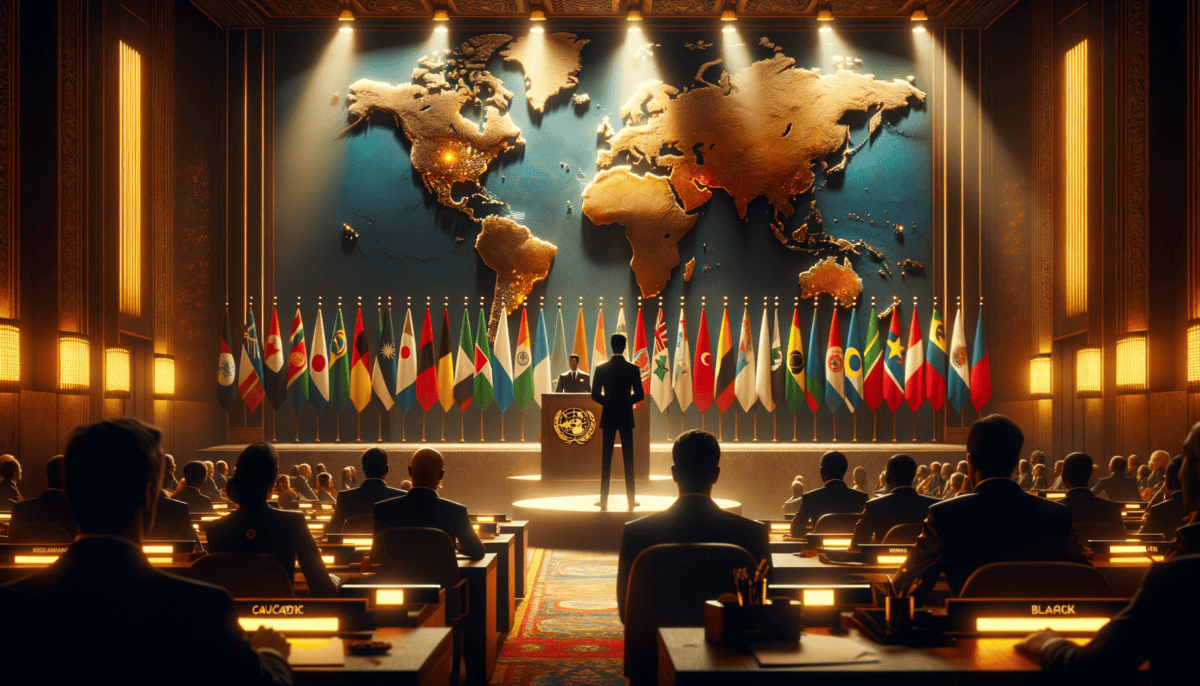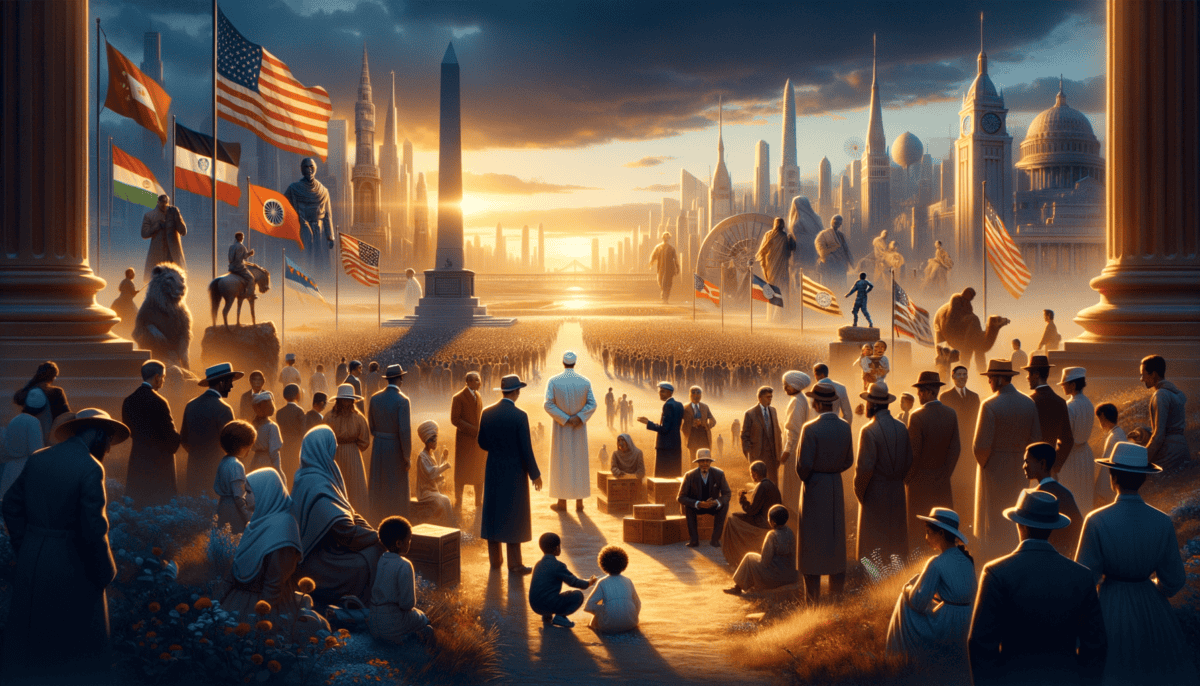Seeds of Resistance
The warm Indian sun beat down on Maya's face as she watched her father join the crowd gathering in their small village square. It was 1947, and change was in the air.
"Papa, why are so many people here today?" Maya asked, tugging at her father's sleeve.
Her father, Rajesh Kumar, smiled down at her. "We are making history today, little one. For too long, others have told us what to do in our own home. But now, we are standing up and saying 'no more.'"
Maya noticed colorful flags waving in the breeze and heard people singing songs about freedom. The excitement was contagious, even though she didn't fully understand what was happening.
“Freedom is not just a word, it’s our birthright,” boomed a voice through the crowd.
The speaker was Arun Patel, a local teacher who had become a leader in their village's independence movement. His words made the crowd cheer and clap.
A Child’s View of Change
At school the next day, Maya noticed things were different. Her teacher, Miss Thompson, who usually taught them English songs, looked worried. Some students weren't in class anymore – their families had moved away.
"Why are things changing?" Maya asked her best friend Priya during lunch.
Priya shared her chapati while explaining, "My papa says the British are leaving. We will rule ourselves now."
• People started peaceful protests
• Leaders like Gandhi showed how to fight without violence
• Many countries started wanting freedom
• British power became weaker after World War II
Maya wrote in her diary that night:
Dear Diary,
Today I learned that being brave means standing up for what's right. Papa says we are part of something big. He says it's like when a bird finally leaves its nest – scary but necessary for freedom. I wonder what tomorrow will bring?
The meetings in the village square became more frequent. Maya watched as her father and other villagers practiced something called "civil disobedience." They would sit quietly in front of government buildings, refusing to move.
"But won't they get in trouble?" Maya asked her mother.
"Sometimes being brave means facing trouble," her mother explained, weaving at her loom. "But when many people are brave together, even the strongest empire must listen."
The Spark Spreads
News traveled through the village about other independence movements. People whispered about freedom fighters in Africa and Asia. Maya learned that her small village was part of something much bigger.
One evening, as the family sat under their neem tree, Rajesh told stories about leaders in other lands fighting for the same dreams. "From Ghana to Indonesia, people are waking up. They want to decide their own future."
The air felt electric with possibility. Change was coming, not just to India, but to the whole world. Maya could feel it in the songs people sang, in the determined faces of the villagers, and in the way even children like her started dreaming of a different tomorrow.
As darkness fell and stars appeared in the sky, Maya asked, "Papa, what happens after we get freedom?"
Rajesh pulled her close. "Then, little one, we build. We build a nation where every child can dream big dreams. Where we make our own choices and write our own story."
Voices of Change
The hot African sun blazed over Ghana as young Kwame ran through the bustling streets of Accra. It was 1951, and the air buzzed with excitement.
“Kwame! Did you hear? Nkrumah is speaking today!” his friend Kofi called out, waving a newspaper.
The Birth of a Dream
In the town square, thousands gathered to hear Kwame Nkrumah speak. Kwame and Kofi squeezed through the crowd to get closer. The future leader of Ghana stood tall, his voice carrying across the square:
“We want to show the world that Africa can shine bright. That we can rule ourselves!”
The crowd erupted in cheers. Kwame felt his heart swell with pride. He turned to Kofi and whispered, “One day, I want to help build our free nation too.”
• People formed new political parties
• Leaders wrote newspapers about freedom
• Communities held peaceful protests
• Countries started gaining independence
A Tale of Two Friends
After the speech, Kwame and Kofi sat under a large baobab tree, sharing roasted peanuts. “My father says things are changing all over Africa,” Kofi said. “Even in Kenya, they’re fighting for freedom.”
That evening, Kwame wrote in his notebook:
Today I saw hope in people’s eyes. Teacher says we’re not just fighting for Ghana – we’re fighting for all of Africa. Even the mighty British Empire can’t stop an idea whose time has come.
Echoes Across the Continent
News traveled fast about other African nations. In Kenya, Jomo Kenyatta was leading his own freedom movement. Stories spread of brave men and women standing up to colonial rule.
“Mama,” Kwame asked one evening while helping prepare fufu, “why do we need independence?”
His mother smiled wisely. “Think of it like this: if someone came to our house and told us how to cook our own food, how to speak, how to live – would that be right?”
“No!” Kwame shook his head firmly.
“That’s what independence means – cooking our own food, speaking our own languages, making our own choices.”
The Winds of Change
Months passed, and changes came quickly. New African flags appeared in windows. People spoke openly about freedom. Even in school, teachers began teaching African history alongside European history.
One day, Kwame heard singing in the streets. A group of women moved past, their voices strong and clear:
“Freedom is coming, oh yes I know
Tomorrow belongs to us, oh yes I know”
As the sun set over Accra, Kwame and Kofi sat on Kwame’s roof, watching the city lights twinkle. “Do you think we’ll really be free?” Kofi asked.
Kwame looked at the stars above Africa’s changing landscape. “Yes,” he said firmly. “And when we are, we’ll build something amazing.”
Breaking Chains
The warm Caribbean breeze rustled through Kingston’s palm trees as Maya watched her father, Norman Manley, prepare for another important meeting. It was 1955, and Jamaica was alive with dreams of freedom.
Dreams Under the Island Sun
“Papa, tell me again why we need to be free,” Maya asked, helping him organize his papers.
Norman smiled, sitting beside his daughter. “Look at our beautiful island,” he said. “For too long, others have told us what to do with our land, our sugar cane, even our music. It’s time we make our own choices.”
“Freedom isn’t just about big changes – it’s about being proud of who we are and what we can become.”
Songs of Liberty
That evening, Maya heard music floating from the town square. People gathered, playing drums and singing traditional songs. The rhythm of freedom was in the air:
“Rise up, rise up
Our time has come
Jamaica’s children
Dancing in the sun”
• Making their own newspapers
• Writing songs about freedom
• Having peaceful meetings
• Teaching children their history
Across the Ocean
Meanwhile, in faraway Indonesia, young Amir listened to President Sukarno speak on the radio. The whole family gathered around, eyes shining with hope.
“Our islands stretch like emeralds across the sea,” Sukarno’s voice crackled through the speaker. “We must protect them, build them, make them shine!”
Amir’s grandmother nodded wisely. “When I was young, we could only whisper about freedom. Now we shout it from the rooftops! ️”
Two Worlds, One Dream
Back in Jamaica, Maya wrote letters to her pen pal in Indonesia:
Dear Amir,
Our islands may be far apart, but our hearts beat the same rhythm. Papa says freedom is like a sunrise – once it starts, nothing can stop it.
The Power of Culture
In both Jamaica and Indonesia, people began wearing traditional clothes proudly. They spoke their local languages more often. They told their own stories.
“Look,” Maya’s teacher said one day, pointing to a world map. “Freedom is spreading like a beautiful rainbow across the world. Each country adds its own color.”
Amir, too, noticed changes in his hometown. Local markets grew busier. People walked taller. Hope sparkled in every conversation.
A New Dawn
One morning, Maya found her father crying happy tears. “What’s wrong, Papa?” she asked.
“Nothing’s wrong, sweet girl,” he smiled. “Everything’s right. We’re getting closer to freedom every day.”
That night, as stars twinkled over both Jamaica and Indonesia, two children in different parts of the world dreamed the same dream – of nations standing proud and free, ready to write their own stories.
The Algerian Crucible
The sun beat down on the dusty streets of Algiers as twelve-year-old Amira watched her older brother Omar pack his bag. The year was 1954, and change was in the air.
A Family’s Choice
"Where are you going?" Amira whispered, though she already knew the answer.
Omar hugged his sister tight. "I'm joining the FLN. It's time we fight for our freedom, little one."
“Sometimes being brave means standing up for what’s right, even when it’s hard.”
Secret Messages
Amira became her brother’s secret helper. She carried messages hidden in her schoolbooks, watching French soldiers pass by without suspecting the little girl with braids. Her heart would pound, but she never showed her fear.
Mama taught her a special code:
Two knocks = safe
Three knocks = message ready
The Brave Women
At night, Amira watched the women of her neighborhood gather. They weren’t just mothers and sisters anymore – they were freedom fighters too.
Her neighbor Fatima, once just a quiet grandmother, now helped hide important papers. “We all have a part to play,” she told Amira with a wink.
News From the Mountains
Sometimes, radio messages would crackle through their hidden receiver:
"The spirit of freedom grows stronger each day
From the mountains to the sea
We will not rest until Algeria is free"
The World Watches
In their small kitchen, Amira overheard grown-ups talking about other countries supporting their fight. “Even at the United Nations, they’re talking about Algeria!” her father said proudly.
• Sharing food with fighters
• Hiding important messages
• Teaching children their history
• Caring for the wounded
• Keeping hope alive
Small Victories
Each day brought news – some good, some bad. But Amira noticed more people joining their cause. Even children helped by singing freedom songs and keeping watch.
“Every little act of bravery counts,” Omar wrote in his rare letters home. “Even your smallest sister is a hero.”
A City Changed
The streets of Algiers transformed. Where French flags once flew, people now whispered of independence. Secret meetings happened in basements. Hope spread like wildfire.
Amira kept a diary under her mattress:
Dear Diary,
Today I saw more soldiers than ever. But I also saw more smiles. Papa says that's because people can taste freedom coming. I hope Omar comes home soon to taste it too.
The Price of Freedom
Not everything was easy. Some neighbors disappeared. Others came home hurt. But still, people fought on.
“Why don’t we just give up?” Amira asked her mother one hard day.
“Because freedom is like air,” Mama answered, kneading bread with strong hands. “Once you know you need it, you’ll do anything to have it.”
Dreams of Tomorrow
At night, Amira would look at stars through her window, imagining a free Algeria. She dreamed of Omar coming home, of children playing without fear, of proud Algerian flags waving in the wind.
The struggle wasn’t over, but something had changed forever. In the hearts of even the smallest Algerians, freedom had taken root and would not be stopped.
Global Transformation
The world was changing faster than anyone could imagine. It was 1960, and Maria sat in her classroom in Ghana, drawing little flags in her notebook. Just three years ago, her country had become free. Now, she watched as more African nations joined them.
A Special Radio Day
“Children, gather round,” Mr. Kwesi called, turning up the radio. “History is happening!”
The class huddled close to hear the crackly voice announce: “And today, the Democratic Republic of Congo declares its independence!”
“This is the year of Africa,” Mr. Kwesi said, his eyes shining. “Seventeen new nations will be born this year alone!”
Letters Across Oceans
Maria had pen pals in other newly free countries. She pulled out her latest letter from Raj in India:
Dear Maria,
Our independence came first, but we cheer for every new free nation. My father says it’s like watching stars appear in the night sky – one by one, then suddenly, everywhere!
The Freedom Map
In class, they had a special map where they colored each country as it became independent. The colors spread like rainbow patches:
• Cameroon
• Togo
• Madagascar
• Somalia
• Niger
• And many more!
Dancing in the Streets
Every time news came of another country’s freedom, people celebrated. Maria loved watching the parades, where people wore their brightest clothes and sang songs in different languages.
“Look how many flags we have now!” her little brother Kofi said, pointing at the United Nations building photo in the newspaper.
Friendship Games
During recess, children played new games, pretending to be diplomats from different countries. They made up peaceful ways to solve problems and helped each other learn words from other languages.
“When I grow up,” Maria told her friends, “I want to work at the UN and help all countries be friends.”
Changes Big and Small
Things were different now. They learned their own history in school, not just European history. They could speak their local languages proudly. Even the money had African faces on it!
But some things were hard. Maria’s uncle worked in the government and often came home tired.
“Building a new nation isn’t easy,” he’d say, “but it’s worth every effort.” ️
Messages of Hope
Maria started a school newspaper called “The Freedom Star.” In it, she wrote:
“Every week, our world family grows bigger. We may speak different languages and eat different foods, but we all want the same thing – to be free and happy.” ⭐
Looking Forward
One evening, sitting on their porch, Maria’s grandmother told stories of the old days under colonial rule.
“But now,” she smiled, patting Maria’s hand, “you children will write new stories. Better stories.”
The evening air was warm with possibility. Somewhere in the distance, drums played a freedom beat, and Maria knew that tomorrow would bring more news of liberation, more colors to add to their map, more friends to welcome to the family of free nations.
Legacy of Freedom
The sun rose over a changed world in 1965. Ten-year-old Maria, now a teenager, sat under the same mango tree where she used to draw flags. Her beloved teacher Mr. Kwesi had become the town mayor.
Dear Diary
Today marks five years since the Year of Africa. Our “Freedom Star” newspaper is now read by children across three countries! Yesterday, I received letters from students in Tanzania, Nigeria, and India…
Building Dreams
Maria walked through her hometown, noting the changes. New schools stood proud, their walls decorated with African art. Markets buzzed with traders from different nations.
“Look!” Kofi pointed to a construction site. “They’re building our first university!”
Growing Pains
Not everything was easy. Maria overheard adults discussing challenges:
• Learning to run our own government
• Building new roads and schools
• Trading with other countries
• Keeping our culture strong while moving forward
The Unity Festival
Maria helped organize a special celebration bringing together people from newly independent nations. Children performed traditional dances, shared food, and told stories of their countries’ journeys to freedom.
“We may have different flags,” Maria announced to the crowd, “but our hearts beat the same freedom drum.”
Grandmother’s Wisdom
One evening, Maria’s grandmother held a story circle with neighborhood children:
“Remember, little ones,” she said, her voice gentle but firm, “freedom isn’t just about having our own flag. It’s about building something beautiful together.”
The Future Calls
Maria’s school now offered classes in local languages alongside English. Students learned both traditional wisdom and modern science.
“We’re not just copying other countries,” Mr. Kwesi explained during a community meeting. “We’re creating something new – taking the best of our past and mixing it with new ideas.”
A Special Project
Maria started a garden project at school, growing plants from different African countries. Each plant had a story tag explaining its origins and traditional uses.
“This is how we grow together,” she told visitors. “Different plants, same garden, all helping each other thrive.”
Messages Across Time
The class buried a time capsule containing:
“To the children of tomorrow: We are the first generation of free Africans. We face many challenges, but we face them standing tall. Our parents won freedom. Now we build the dream.” ⭐
The Never-Ending Story
As Maria prepared for bed, she gazed at her wall map. The colors of independence now covered most of the world. But she knew this wasn’t the end of the story.
“What happens after freedom?” she had asked Mr. Kwesi.
“That’s the most exciting part,” he smiled. “We get to write that story ourselves, page by page, day by day.”
Outside, the evening star twinkled bright, like a beacon guiding ships to shore. In homes across the continent, children dreamed of tomorrow. They were no longer subjects of distant empires, but authors of their own destiny. The path ahead might not be easy, but it was their path to walk.
And somewhere, in a classroom much like Maria’s, another child was drawing flags, dreaming dreams, and adding their own colors to the great story of freedom.


